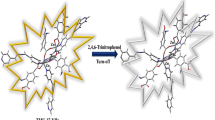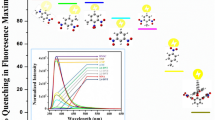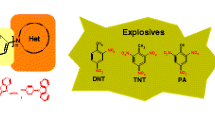Abstract
Nitro-aromatic compounds have a deleterious effect on the environment and they are extremely explosive. Therefore, societal concern about exposure to nitro-aromatic compounds encourages researchers to develop selective and sensitive detection platforms for nitro-aromatic compounds in recent years. In this paper, a new 100% water-soluble cyclotriphosphazene-based bridged naphthalene material (4) was prepared as a small molecule fluorescent sensor for ultra-selective detection of nitro-aromatic compounds. The chemical structure of 4 was extensively characterized by mass spectrometry and nuclear magnetic resonance spectroscopies (31P, 13C, 1H). The photo-physical properties of the newly developed sensing system were investigated by steady-state fluorescence and UV–Vis absorption spectroscopies. The fluorescence sensor behaviors were extensively evaluated after treatment with the most commonly used metal cations, anions, competitive aromatic compounds, saccharides, and organic acids. The developed fluorescent sensing system (4) demonstrated ultra-selective fluorescence “turn-off” signal change toward nitro-aromatic compounds while other tested competitive species caused negligible changes. To evaluate selectivity, time-resolved, steady-state 3D-fluorescence and UV–Vis absorption spectroscopies were used in fully aqueous media. Moreover, theoretical calculations (density functional theory and time-dependent density functional theory) were applied and discussed to identify fluorescence sensing mechanisms toward nitroaromatic compounds for the presented sensing system.
Graphical abstract









Similar content being viewed by others
Availability of data and materials
The authors do declare that all raw and/or processed data possessed by them and provided in this contribution are available to the Journal's Editor upon any such request.
References
Shanmugaraju, S., & Mukherjee, P. S. (2015). π-Electron rich small molecule sensors for the recognition of nitroaromatics. Chemical Communications, 51, 16014–16032. https://doi.org/10.1039/C5CC07513K
Ardic Alidagi, H., Tümay, S. O., Şenocak, A., Çiftbudak, Ö. F., Çoşut, B., & Yeşilot, S. (2019). Constitutional isomers of dendrimer-like pyrene substituted cyclotriphosphazenes: Synthesis, theoretical calculations, and use as fluorescence receptors for the detection of explosive nitroaromatics. New Journal of Chemistry, 43, 16738–16747. https://doi.org/10.1039/C9NJ03695D
Yew, Y. T., Ambrosi, A., & Pumera, M. (2016). Nitroaromatic explosives detection using electrochemically exfoliated graphene. Scientific Reports, 6, 33276. https://doi.org/10.1038/srep33276
Ostafin, M., & Nogaj, B. (2007). 14N-NQR based device for detection of explosives in landmines. Measurement, 40, 43–54. https://doi.org/10.1016/j.measurement.2006.04.003
Hakimifar, A., & Morsali, A. (2019). High-sensitivity detection of nitroaromatic compounds (NACs) by the pillared-layer metal-organic framework synthesized via ultrasonic method. Ultrasonics Sonochemistry, 52, 62–68. https://doi.org/10.1016/j.ultsonch.2018.11.002
Shi, X., Qiu, X., Jiang, X., Rudich, Y., & Zhu, T. (2021). Comprehensive detection of nitrated aromatic compounds in fine particulate matter using gas chromatography and tandem mass spectrometry coupled with an electron capture negative ionization source. Journal of Hazardous Materials, 407, 124794. https://doi.org/10.1016/j.jhazmat.2020.124794
Heleg-Shabtai, V., Sharabi, H., Zaltsman, A., Ron, I., & Pevzner, A. (2020). Surface-enhanced Raman spectroscopy (SERS) for detection of VX and HD in the gas phase using a hand-held Raman spectrometer. The Analyst, 145, 6334–6341. https://doi.org/10.1039/D0AN01170C
Tümay, S. O. (2021). A novel selective “turn-on” fluorescent chemosensor based on thiophene appended cyclotriphosphazene schiff base for detection of Ag+ ions. Chemistry, 6, 10561–10572. https://doi.org/10.1002/slct.202102052
Tümay, S. O., Irani-Nezhad, M. H., & Khataee, A. (2021). Multi-anthracene containing fluorescent probe for spectrofluorimetric iron determination in environmental water samples. Spectrochimica Acta Part A: Molecular and Biomolecular Spectroscopy, 248, 119250. https://doi.org/10.1016/j.saa.2020.119250
Tümay, S. O., Şenocak, A., & Mermer, A. (2021). A “turn-on” small molecule fluorescent sensor for the determination of Al3+ ion in real samples: Theoretical calculations, and photophysical and electrochemical properties. New Journal of Chemistry, 45, 18400–18411. https://doi.org/10.1039/D1NJ03462F
Samanta, D., Shanmugaraju, S., Joshi, S. A., Patil, Y. P., Nethaji, M., & Mukherjee, P. S. (2012). Pillar height dependent formation of unprecedented Pd8 molecular swing and Pd6 molecular boat via multicomponent self-assembly. Chemical Communications, 48, 2298–2300. https://doi.org/10.1039/C2CC16345D
Tang, B., Ding, B., Xu, K., & Tong, L. (2009). Use of selenium to detect mercury in water and cells: an enhancement of the sensitivity and specificity of a seleno fluorescent probe. Chemistry: A European Journal, 15, 3147–3151. https://doi.org/10.1002/chem.200802165
Kartha, K. K., Sandeep, A., Praveen, V. K., & Ajayaghosh, A. (2015). Detection of nitroaromatic explosives with fluorescent molecular assemblies and π-gels. The Chemical Record, 15, 252–265. https://doi.org/10.1002/tcr.201402063
Xu, S., & Lu, H. (2015). Ratiometric fluorescence and mesoporous structure dual signal amplification for sensitive and selective detection of TNT based on MIP@QD fluorescence sensors. Chemical Communications, 51, 3200–3203. https://doi.org/10.1039/C4CC09766A
Nagarkar, S. S., Desai, A. V., Samanta, P., & Ghosh, S. K. (2015). Aqueous phase selective detection of 2,4,6-trinitrophenol using a fluorescent metal–organic framework with a pendant recognition site. Dalton Transactions, 44, 15175–15180. https://doi.org/10.1039/C5DT00397K
Rochat, S., & Swager, T. M. (2013). Conjugated amplifying polymers for optical sensing applications. ACS Applied Materials & Interfaces, 5, 4488–4502. https://doi.org/10.1021/am400939w
Shaw, P. E., Chen, S. S. Y., Wang, X., Burn, P. L., & Meredith, P. (2013). High-generation dendrimers with excimer-like photoluminescence for the detection of explosives. The Journal of Physical Chemistry C, 117, 5328–5337. https://doi.org/10.1021/jp4002884
Huguet, N., Jevtovikj, I., Gordillo, A., Lejkowski, M. L., Lindner, R., Bru, M., Khalimon, A. Y., Rominger, F., Schunk, S. A., Hofmann, P., & Limbach, M. (2014). Nickel-catalyzed direct carboxylation of olefins with CO2: One-pot synthesis of α, β-unsaturated carboxylic acid salts. Chemistry—A European Journal, 20, 16858–16862. https://doi.org/10.1002/chem.201405528
McCluskey, A., Holdsworth, C. I., & Bowyer, M. C. (2007). Molecularly imprinted polymers (MIPs): Sensing, an explosive new opportunity? Organic & Biomolecular Chemistry, 5, 3233–3244. https://doi.org/10.1039/B708660A
Kaur, S., Gupta, A., Bhalla, V., & Kumar, M. (2014). Pentacenequinone derivatives: Aggregation-induced emission enhancement, mechanism and fluorescent aggregates for superamplified detection of nitroaromatic explosives. Journal of Materials Chemistry C, 2, 7356–7363. https://doi.org/10.1039/C4TC01194E
Chopra, R., Bhalla, V., Kumar, M., & Kaur, S. (2015). Rhodamine appended hexaphenylbenzene derivative: Through bond energy transfer for sensing of picric acid. RSC Advances, 5, 24336–24341. https://doi.org/10.1039/C5RA00436E
Tümay, S. O., & Yeşilot, S. (2021). Small molecule based water-soluble fluorescence material for highly selective and ultra-sensitive detection of TNT: Design and spectrofluorimetric determination in real samples. Sensors and Actuators B: Chemical, 343, 130088. https://doi.org/10.1016/j.snb.2021.130088
Mosca, L., Karimi Behzad, S., & Anzenbacher, P. (2015). Small-molecule turn-on fluorescent probes for RDX. Journal of the American Chemical Society, 137, 7967–7969. https://doi.org/10.1021/jacs.5b04643
Venkatramaiah, N., Pereira, C. F., Mendes, R. F., Paz, F. A. A., & Tomé, J. P. C. (2015). Phosphonate appended porphyrins as versatile chemosensors for selective detection of trinitrotoluene. Analytical Chemistry, 87, 4515–4522. https://doi.org/10.1021/acs.analchem.5b00772
Ma, X.-S., Wang, D.-H., Cui, Y.-Z., Tao, F.-R., Wang, Y.-T., & Li, T.-D. (2017). A novel hydrophilic conjugated polymer containing hydroxyl groups: Syntheses and sensing performance for NACs in aqueous solution. Sensors and Actuators B: Chemical, 251, 851–857. https://doi.org/10.1016/j.snb.2017.05.120
Aathimanikandan, S. V., Sandanaraj, B. S., Arges, C. G., Bardeen, C. J., & Thayumanavan, S. (2005). Effect of guest molecule flexibility in access to dendritic interiors. Organic Letters, 7, 2809–2812. https://doi.org/10.1021/ol050579b
Fery-Forgues, S., & Lavabre, D. (1999). Are fluorescence quantum yields so tricky to measure? A demonstration using familiar stationery products. Journal of Chemical Education, 76, 1260. https://doi.org/10.1021/ed076p1260
Melhuish, W. H. (1961). Quantum efficiencies of fluorescence of organic substances: Effect of solvent and concentration of the fluorescent solute1. The Journal of Physical Chemistry, 65, 229–235. https://doi.org/10.1021/j100820a009
Prabakaran, S., Nisha, K. D., Harish, S., Archana, J., & Navaneethan, M. (2021). Yttrium incorporated TiO2/rGO nanocomposites as an efficient charge transfer layer with enhanced mobility and electrical conductivity. Journal of Alloys and Compounds, 885, 160936. https://doi.org/10.1016/j.jallcom.2021.160936
Frisch, M.J., Trucks, G.W., Schlegel, H.B., Scuseria, G.E., Robb, M.A., Cheeseman, J.R., Scalmani, G., Barone, V., Petersson, G.A., Nakatsuji, H., Li, X., Caricato, M., Marenich, A.V., Bloino, J., Janesko, B.G., Gomperts, R., Mennucci, B., Hratchian, H.P., Ortiz, J.V., Izmaylov, A.F., Sonnenberg, J.L., Williams, Ding, F., Lipparini, F., Egidi, F., Goings, J., Peng, B., Petrone, A., Henderson, T., Ranasinghe, D., Zakrzewski, V.G., Gao, J., Rega, N., Zheng, G., Liang, W., Hada, M., Ehara, M., Toyota, K., Fukuda, R., Hasegawa, J., Ishida, M., Nakajima, T., Honda, Y., Kitao, O., Nakai, H., Vreven, T., Throssell, K., Montgomery Jr., J.A., Peralta, J.E., Ogliaro, F., Bearpark, M.J., Heyd, J.J., Brothers, E.N., Kudin, K.N., Staroverov, V.N., Keith, T.A., Kobayashi, R., Normand, J., Raghavachari, K., Rendell, A.P., Burant, J.C., Iyengar, S.S., Tomasi, J., Cossi, M., Millam, J.M., Klene, M., Adamo, C., Cammi, R., Ochterski, J.W., Martin, R.L., Morokuma, K., Farkas, O., Foresman, J.B., & Fox, D.J. (2016). Gaussian 16 Rev. C.01, in, Wallingford, CT.
Shkir, M., Muhammad, S., AlFaify, S., Irfan, A., Patil, P. S., Arora, M., Algarni, H., & Jingping, Z. (2015). An investigation on the key features of a D–π–A type novel chalcone derivative for opto-electronic applications. RSC Advances, 5, 87320–87332. https://doi.org/10.1039/C5RA13494C
Özcan, E., Tümay, S. O., Keşan, G., Yeşilot, S., & Çoşut, B. (2019). The novel anthracene decorated dendrimeric cyclophosphazenes for highly selective sensing of 2,4,6-trinitrotoluene (TNT). Spectrochimica Acta Part A: Molecular and Biomolecular Spectroscopy, 220, 117115. https://doi.org/10.1016/j.saa.2019.05.020
Uslu, A., Özcan, E., Tümay, S. O., Kazan, H. H., & Yeşilot, S. (2020). Development of a synthetic strategy for Water soluble tripodal receptors: Two novel fluorescent receptors for highly selective and sensitive detections of Fe3+ and Cu2+ ions and biological evaluation. Journal of Photochemistry and Photobiology A: Chemistry, 392, 112411. https://doi.org/10.1016/j.jphotochem.2020.112411
Mondal, K., Bhattacharyya, S., & Sharma, A. (2014). Photocatalytic degradation of naphthalene by electrospun mesoporous carbon-doped anatase TiO2 nanofiber mats. Industrial & Engineering Chemistry Research, 53, 18900–18909. https://doi.org/10.1021/ie5025744
Tümay, S. O., & Yeşilot, S. (2019). Tripodal synthetic receptors based on cyclotriphosphazene scaffold for highly selective and sensitive spectrofluorimetric determination of iron(III) in water samples. Journal of Photochemistry and Photobiology A: Chemistry, 372, 156–167. https://doi.org/10.1016/j.jphotochem.2018.12.012
Tümay, S. O. (2021). Tripodal structured blue-green emissive fluorescent sensors for highly selective bifunctional detection: Their logic gate operations and real sample applications. Journal of Luminescence, 231, 117813. https://doi.org/10.1016/j.jlumin.2020.117813
Zhang, Q., Zhang, D., Lu, Y., Yao, Y., Li, S., & Liu, Q. (2015). Graphene oxide-based optical biosensor functionalized with peptides for explosive detection. Biosensors and Bioelectronics, 68, 494–499. https://doi.org/10.1016/j.bios.2015.01.040
Carrillo-Carrión, C., Simonet, B. M., & Valcárcel, M. (2013). Determination of TNT explosive based on its selectively interaction with creatinine-capped CdSe/ZnS quantum dots. Analytica Chimica Acta, 792, 93–100. https://doi.org/10.1016/j.aca.2013.07.004
Goodpaster, J. V., & McGuffin, V. L. (2001). Fluorescence quenching as an indirect detection method for nitrated explosives. Analytical Chemistry, 73, 2004–2011. https://doi.org/10.1021/ac001347n
Sanchez, J. C., DiPasquale, A. G., Rheingold, A. L., & Trogler, W. C. (2007). Synthesis, luminescence properties, and explosives sensing with 1,1-tetraphenylsilole- and 1,1-silafluorene-vinylene polymers. Chemistry of Materials, 19, 6459–6470. https://doi.org/10.1021/cm702299g
Khasanov, A. F., Kopchuk, D. S., Kovalev, I. S., Taniya, O. S., Giri, K., Slepukhin, P. A., Santra, S., Rahman, M., Majee, A., Charushin, V. N., & Chupakhin, O. N. (2017). Extended cavity pyrene-based iptycenes for the turn-off fluorescence detection of RDX and common nitroaromatic explosives. New Journal of Chemistry, 41, 2309–2320. https://doi.org/10.1039/C6NJ02956F
Fan, L., Hu, Y., Wang, X., Zhang, L., Li, F., Han, D., Li, Z., Zhang, Q., Wang, Z., & Niu, L. (2012). Fluorescence resonance energy transfer quenching at the surface of graphene quantum dots for ultrasensitive detection of TNT. Talanta, 101, 192–197. https://doi.org/10.1016/j.talanta.2012.08.048
Kumar, V., Maiti, B., Chini, M. K., De, P., & Satapathi, S. (2019). Multimodal fluorescent polymer sensor for highly sensitive detection of nitroaromatics. Scientific Reports, 9, 7269. https://doi.org/10.1038/s41598-019-43836-w
Stringer, R. C., Gangopadhyay, S., & Grant, S. A. (2010). Detection of nitroaromatic explosives using a fluorescent-labeled imprinted polymer. Analytical Chemistry, 82, 4015–4019. https://doi.org/10.1021/ac902838c
Tanwar, A. S., Parui, R., Garai, R., Chanu, M. A., & Iyer, P. K. (2022). Dual “static and dynamic” fluorescence quenching mechanisms based detection of TNT via a cationic conjugated polymer. ACS Measurement Science Au, 2, 23–30. https://doi.org/10.1021/acsmeasuresciau.1c00023
Lakowicz, J. R. (2013). Principles of fluorescence spectroscopy. Springer Science & Business Media.
Kumar, V., Saini, S. K., Choudhury, N., Kumar, A., Maiti, B., De, P., Kumar, M., & Satapathi, S. (2021). Highly sensitive detection of nitro compounds using a fluorescent copolymer-based FRET system. ACS Applied Polymer Materials, 3, 4017–4026. https://doi.org/10.1021/acsapm.1c00540
Liu, R., Farinha, J. P. S., & Winnik, M. A. (1999). Preparation and spectroscopic properties of phenanthrene-labeled SEBS triblock copolymers. Macromolecules, 32, 3957–3963. https://doi.org/10.1021/ma990268e
Lee, S., & Winnik, M. A. (1994). Photophysical behavior of oligoethylene glycols labeled with naphthalene carboxylate and phosphate esters. Canadian Journal of Chemistry, 72, 1587–1595. https://doi.org/10.1139/v94-198
Sahu, S., Sikdar, Y., Bag, R., Cerezo, J., Cerón-Carrasco, J. P., & Goswami, S. (2022). Turn on fluorescence sensing of Zn2+ based on fused isoindole-imidazole scaffold. Molecules, 27, 2859. https://doi.org/10.3390/molecules27092859
Tang, Y., Huang, H., Peng, B., Chang, Y., Li, Y., & Zhong, C. (2020). A thiadiazole-based covalent triazine framework nanosheet for highly selective and sensitive primary aromatic amine detection among various amines. Journal of Materials Chemistry A, 8, 16542–16550. https://doi.org/10.1039/C9TA14252E
Zhu, X., Wang, Z., & Wu, Z. (2011). Characterization of membrane foulants in a full-scale membrane bioreactor for supermarket wastewater treatment. Process Biochemistry, 46, 1001–1009. https://doi.org/10.1016/j.procbio.2011.01.020
Mobed, J. J., Hemmingsen, S. L., Autry, J. L., & McGown, L. B. (1996). Fluorescence characterization of IHSS humic substances: Total luminescence spectra with absorbance correction. Environmental Science & Technology, 30, 3061–3065. https://doi.org/10.1021/es960132l
Caron, T., Pasquinet, E., van der Lee, A., Pansu, R. B., Rouessac, V., Clavaguera, S., Bouhadid, M., Serein-Spirau, F., Lère-Porte, J.-P., & Montméat, P. (2014). Efficient sensing of explosives by using fluorescent nonporous films of oligophenyleneethynylene derivatives thanks to optimal structure orientation and exciton migration. Chemistry A European Journal, 20, 15069–15076. https://doi.org/10.1002/chem.201402271
Demirel, G. B., Daglar, B., & Bayindir, M. (2013). Extremely fast and highly selective detection of nitroaromatic explosive vapours using fluorescent polymer thin films. Chemical Communications, 49, 6140–6142. https://doi.org/10.1039/C3CC43202E
He, G., Yan, N., Yang, J., Wang, H., Ding, L., Yin, S., & Fang, Y. (2011). Pyrene-containing conjugated polymer-based fluorescent films for highly sensitive and selective sensing of TNT in aqueous medium. Macromolecules, 44, 4759–4766. https://doi.org/10.1021/ma200953s
Balan, B., Vijayakumar, C., Tsuji, M., Saeki, A., & Seki, S. (2012). Detection and distinction of DNT and TNT with a fluorescent conjugated polymer using the microwave conductivity technique. The Journal of Physical Chemistry B, 116, 10371–10378. https://doi.org/10.1021/jp304791r
Wang, E., Sun, D., Li, H., Sun, X., Liu, J., Ren, Z., & Yan, S. (2016). High efficiency organosilicon-containing polymer sensors for the detection of trinitrotoluene and dinitrotoluene. Journal of Materials Chemistry C, 4, 6756–6760. https://doi.org/10.1039/C6TC01892K
Lee, I., Kwon, J. E., You, C., Kang, Y., & Kim, B.-G. (2019). Instantaneous detection of explosive and toxic nitroaromatic compounds via donor–acceptor complexation. Journal of Materials Chemistry C, 7, 9257–9262. https://doi.org/10.1039/C9TC02401H
Vovusha, H., & Sanyal, B. (2015). DFT and TD-DFT studies on the electronic and optical properties of explosive molecules adsorbed on boron nitride and graphene nano flakes. RSC Advances, 5, 4599–4608. https://doi.org/10.1039/C4RA11314D
Yeşilot, S., Çoşut, B., Alidağı, H. A., Hacıvelioğlu, F., Özpınar, G. A., & Kılıç, A. (2014). Intramolecular excimer formation in hexakis(pyrenyloxy)cyclotriphosphazene: Photophysical properties, crystal structure, and theoretical investigation. Dalton Transactions, 43, 3428–3433. https://doi.org/10.1039/C3DT52957F
Alidağı, H. A., Tümay, S. O., Şenocak, A., & Yeşilot, S. (2018). Pyrene functionalized cyclotriphosphazene-based dyes: Synthesis, intramolecular excimer formation, and fluorescence receptor for the detection of nitro-aromatic compounds. Dyes and Pigments, 153, 172–181. https://doi.org/10.1016/j.dyepig.2018.02.012
Dong, J., Zhang, K., Li, X., Qian, Y., Zhu, H., Yuan, D., Xu, Q.-H., Jiang, J., & Zhao, D. (2017). Ultrathin two-dimensional porous organic nanosheets with molecular rotors for chemical sensing. Nature Communications, 8, 1142. https://doi.org/10.1038/s41467-017-01293-x
Üngördü, A., & Tezer, N. (2017). The solvent (water) and metal effects on HOMO-LUMO gaps of guanine base pair: A computational study. Journal of Molecular Graphics and Modelling, 74, 265–272. https://doi.org/10.1016/j.jmgm.2017.04.015
Zhang, H., Feng, L., Liu, B., Tong, C., & Lü, C. (2014). Conjugation of PPV functionalized mesoporous silica nanoparticles with graphene oxide for facile and sensitive fluorescence detection of TNT in water through FRET. Dyes and Pigments, 101, 122–129. https://doi.org/10.1016/j.dyepig.2013.09.040
Chou, K. F., & Dennis, A. M. (2015). Förster resonance energy transfer between quantum dot donors and quantum dot acceptors. Sensors, 15, 13288–13325. https://doi.org/10.3390/s150613288
Cha, I., Baek, S., Song, S. G., Kim, J., Lee, H. K., Lee, J., Kim, K.-S., & Song, C. (2021). Inter- and intra-hydrogen bonding strategy to control the fluorescence of acylhydrazone-based conjugated microporous polymers and their application to nitroaromatics detection. Macromol, 1, 234–242. https://doi.org/10.3390/macromol1030016
Hu, M.-L., Joharian, M., Razavi, S. A. A., Morsali, A., Wu, D.-Z., Azhdari Tehrani, A., Wang, J., Junk, P. C., & Guo, Z.-F. (2021). Phenolic nitroaromatics detection by fluorinated metal-organic frameworks: Barrier elimination for selective sensing of specific group of nitroaromatics. Journal of Hazardous Materials, 406, 124501. https://doi.org/10.1016/j.jhazmat.2020.124501
Venkatramaiah, N., Firmino, A. D. G., Almeida Paz, F. A., & Tomé, J. P. C. (2014). Fast detection of nitroaromatics using phosphonate pyrene motifs as dual chemosensors. Chemical Communications, 50, 9683–9686. https://doi.org/10.1039/C4CC03980G
Author information
Authors and Affiliations
Contributions
SOT: data curation, conceptualization, methodology, investigation, validation, formal analysis, visualization, writing—original draft, writing—review and editing. AŞ: investigation, visualization, writing—review and editing. BC: investigation, writing—review and editing. HAA: writing—review and editing. SY: supervision, conceptualization, writing—review and editing.
Corresponding author
Ethics declarations
Conflict of interest
On behalf of all authors, the corresponding authors state that there is no conflict of interest.
Supplementary Information
Below is the link to the electronic supplementary material.
Rights and permissions
Springer Nature or its licensor (e.g. a society or other partner) holds exclusive rights to this article under a publishing agreement with the author(s) or other rightsholder(s); author self-archiving of the accepted manuscript version of this article is solely governed by the terms of such publishing agreement and applicable law.
About this article
Cite this article
Tümay, S.O., Şenocak, A., Çoşut, B. et al. A water-soluble small molecular fluorescent sensor based on phosphazene platform for selective detection of nitroaromatic compounds. Photochem Photobiol Sci 22, 1429–1444 (2023). https://doi.org/10.1007/s43630-023-00388-3
Received:
Accepted:
Published:
Issue Date:
DOI: https://doi.org/10.1007/s43630-023-00388-3




